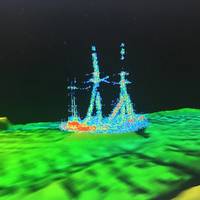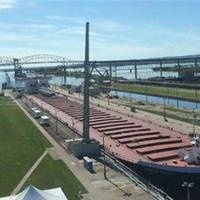Discovery: Historic Shipwreck Found in Lake Huron

Researchers from NOAA, the state of Michigan, and Ocean Exploration Trust discovered an intact shipwreck resting hundreds of feet below the surface of Lake Huron. Located within NOAA's Thunder Bay National Marine Sanctuary, the shipwreck has been identified as the sailing ship Ironton. Well preserved by the cold freshwater of the Great Lakes for over a century, the 191-ft. Ironton rests upright with its three masts still standing."Using this cutting-edge technology, we have not only located a pristine shipwreck lost for over a century…
NOAA-Viking Public Private Partnership, a Win-win for Research

There was important cruise news in January: Viking – a premier European ocean and river cruise company - will offer two new “destination-focused travel experiences,” starting in 2022. One set of cruises becomes Viking’s first foray in the inland North American market, in this case the Great Lakes. Another set of cruises will head to the Arctic and Antarctica. Viking is building two new vessels: the Viking Octantis and the Viking Polaris, under construction now in Norway, by Fincantieri’s VARD.In a press release Viking writes that it has created “the thinking person’s expedition.” Indeed…
Two Shipwrecks Found in Lake Huron
NOAA maritime archaeologists and partners have located and identified two previously undiscovered historic shipwrecks in Thunder Bay National Marine Sanctuary. The shipwrecks are the wooden steamer Ohio (1873-1894) and the steel-hulled steamer Choctaw (1892-1915). In May 2017, a sanctuary-led expedition used high-resolution sonars to map the bottom of Lake Huron, during which they located the two ships. At the time, researchers were confident they had discovered the 202-foot Ohio and the 266-foot Choctaw. The team recently confirmed the vessels’ identities using underwater robots to collect photos and video of the shipwrecks. The sanctuary is planning future expeditions to better understand, manage and interpret Ohio and Choctaw.
Great Lakes Losing Ice
The Great Lakes Environmental Research Laboratory reports ice cover for all of the Great Lakes combined at around 52%, thanks to milder temperatures and gusty winds over the past several weeks. On March 1, nearly 89 percent of the Great Lakes were covered in ice. In just four weeks, the ice coverage on the Great Lakes has decreased almost in half. Winter is fading in the Northland, as it always does, but markedly faster than the past two years. Lake Erie reports ice coverage at around 69%, Lake Superior at 66%, Lake Huron at 58%, Lake Michigan at 21%, and Lake Ontario at 19%. The Iowa Great Lakes are officially declared ice-free for another season. The ice has been off most of western Lake Superior for a couple weeks now. Ice in the Duluth harbor and lower St. Louis River is going fast.
Ice Coverage on Great Lakes 89 pct: NOAA
Ice coverage on the Great Lakes is nearing 90 percent, reveals high resolution satellites images from National Oceanic and Atmospheric Administration (NOAA). The entire Great Lakes is at 88.8 percent ice coverage, with the highest totals coming from Lake Huron and Lake Erie at about 96 percent ice coverage according to Great Lakes Environmental Research Laboratory, part of NOAA. The Laboratory, which monitors the ice coverage of the five Great Lakes, updated some satellite images Saturday showing how much ice is actually covering the Great Lakes. Lake Superior is close behind those two with 95 percent coverage, followed by Lake Michigan with 73 percent and Lake Ontario with 70 percent. According to NOAA data, the Great Lakes ice coverage is up over 3 percent.
Great Lakes Water Levels Surge

Scientists at the Army Corps of Engineers, Environment Canada and NOAA documented a record-setting surge in water levels on Lakes Superior and Michigan-Huron that began in January 2013, and has continued through November 2014. The United States and Canadian federal agencies expect water levels to stay near or above average on all of the Great Lakes over the next six months. At no other point in recorded history have water levels risen as much on Lake Superior and Michigan-Huron over the same two-year period, NOAA said.
Great Lakes Ice Cover Among Worst in 40 Years
The Great Lakes saw some of their worst ice cover in nearly four decades because of a frigid winter with months of below-freezing temperatures in large sections of the northern United States, the National Ocean and Atmospheric Administration said. As of Thursday, 92.2 percent of the five lakes were under ice, breaking a record set in 1973 but still short of the 94.7 percent set in 1979, the federal agency said. The area under ice this winter covered about 86,000 square miles, which is a little bit larger than the state of Minnesota. With a spring thaw approaching and temperatures warming, the 1979 record appears poised to stand for at least another year.
Great Lakes Crisis Continues: Dredging and Water Both Needed
Lake Michigan-Huron sets all-time record for lowest monthly water level. The U.S. Army Corps of Engineers, Detroit District through its Great Lakes Hydraulics and Hydrology Office reports a preliminary new record low water level for Lake Michigan-Huron for the second month in a row. The new record low of 175.57 meters or 576.02 feet is not only the lowest January monthly average water level ever recorded, but also the lowest monthly average ever recorded for any month over the official period of record for Great Lakes water levels, which extends back to 1918. The Corps issues water level forecasts for the Great Lakes in coordination with Environment Canada…
Ambitious Students Participate in "Project Shiphunt"

Sony and Intel’s Project Shiphunt team of young explorers, scientists and historians has returned to shore with news of its underwater discovery: shipwrecks of the schooner M.F. Merrick and the steel freighter Etruria, in deep water off of Presque Isle in Lake Huron. The project was completed with “much thanks to pings, processing and 3D,” according to one marine archaeologist. Current Media, the Peabody-and Emmy Award-winning independent television and online network founded in 2005, will air their adventure as the hour-long special, “Project Shiphunt,” on August 30th at 10 p.m. ET.
NOAA Research Vessel on Vegetarian Diet
The Huron Explorer, a 41-ft. former Coast Guard vessel now serving on the Great Lakes is the first modern U.S. research vessel to operate free of petroleum products. A National Oceanic and Atmospheric Administration (NOAA) small research vessel is now powered by soybeans. The Huron Explorer, a 41-ft. former Coast Guard vessel now serving on the Great Lakes, is the first U.S. research vessel to operate free of petroleum products. The vessel was given an award by the Department of Energy's Federal Energy Management Program during an Earth Day Week event on the shores of Lake Michigan. "NOAA has a commitment to stewardship of the environment, and this research vessel, the R/V Huron Explorer, demonstrates that commitment in very practical ways.





